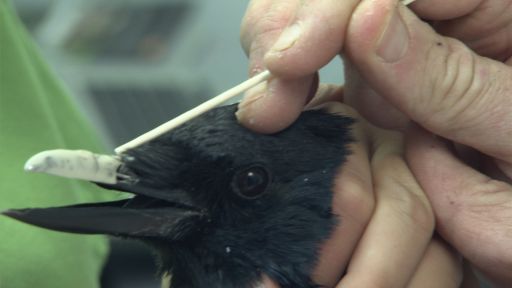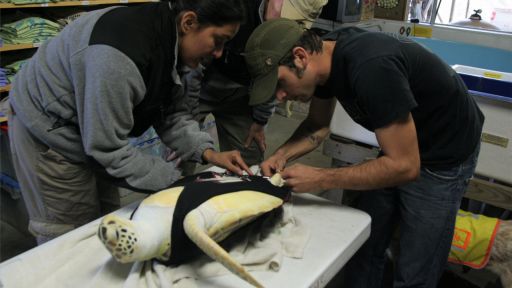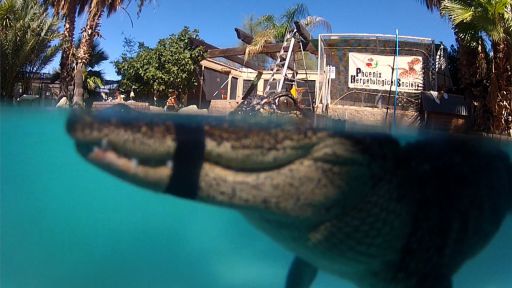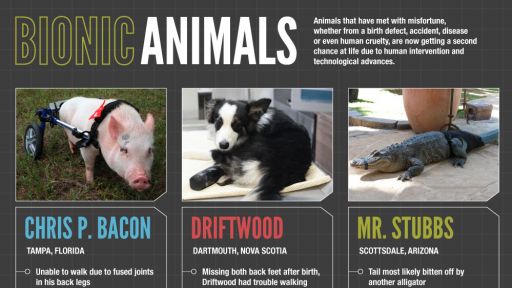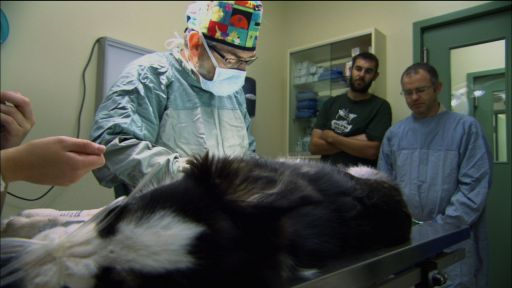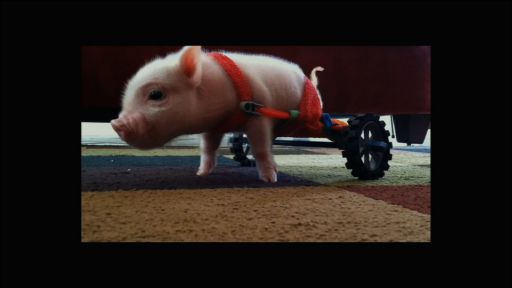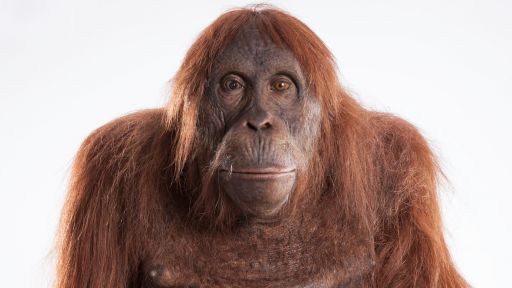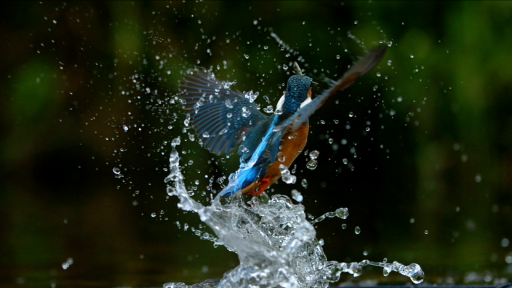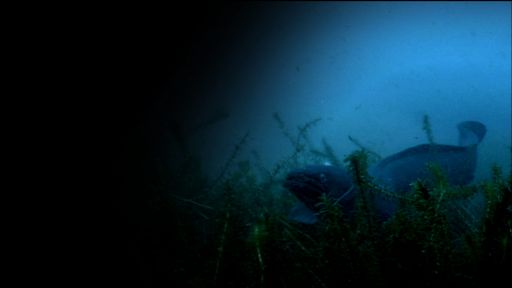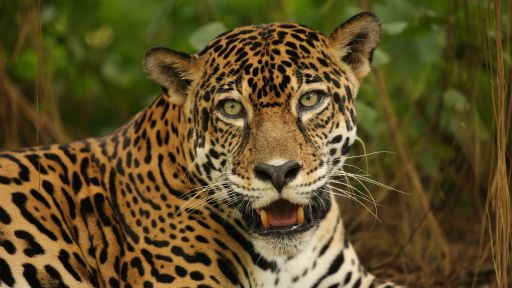TRANSCRIPT
WOMAN: Roofus!
Come here!
MAN: This old notion about, "An animal will do fine
on three legs" --
the obvious one is a dog with three legs.
They can do fine.
I think an animal could do awesome with four legs.
One of which -- or all four -- happen to be prosthetics.
MAN: The time for him to be euthanized is long gone.
-WOMAN: Aww.
-MAN: Yeah, poor guy.
MAN: He's alive, he's here,
so we have to figure out something for him.
[Grunting]
MAN: Here you go, buddy, here you go!
When he's in his wheels, he acts like a normal pig.
This is a very serious injury.
There's no handbook,
there is your imagination and your skill,
and sometimes it works, and sometimes not.
MAN: People have asked us 100 times
why we would do this.
Just because nobody'd ever done it before, why not?
WOMAN: When I found it that he was born with a paw missing,
I just automatically had a soft spot in my heart for him.
WOMAN: Animals can provide a really great bridge
into understanding prosthetics and understanding disability.
MAN: We have the technology to go back to normal.
We can do it for people, we can do it for animals.
WOMAN: There's been quite a bit of emotion leading up to it.
Will he accept them right away, how will he use them,
will he want them at all?
We're ready to see how he walks for the first time.
You ready, buddy?
Ah, here we go!
MAN: Driftwood!
Hey!
[Whistling]
Aww, you sneaky boy!
WOMAN: Driftwood is a five-month-old
border collie puppy who was born on a sheep farm
in Nova Scotia.
Do you want to play with this?
And around the time of his birth,
he lost three to four inches
of the bottom of his back legs on both sides.
MAN: They're bred specifically to work.
As crude as it could be to say,
the time for him to be euthanized is long gone.
He's alive, he's here,
so we have to figure out something for him.
DEVON: We don't know for sure
exactly what happened to Driftwood.
You want that one?
What a good boy!
Good choice!
[Chuckles]
It's thought, though, that his mother
accidentally nipped off the back feet just after birth.
TARA: His feet would have been quite tiny
and they would be covered in placenta liquid.
She was a first-time mother and was apparently quite, uh,
quite meticulous
about cleanliness with her puppies.
WOMAN: I think the fact that we're now rethinking
many of those cases of euthanasia
shows you how far we've come, in terms of
our relationship with animals, and how we view animals,
and what rights we think animals should be afforded.
TARA: It's definitely presented some challenges.
We have to be very conscious
of the surface that he's walking on.
He isn't able to get much traction
on a slippery surface.
DEVON: Aww, that one didn't work too well, you poor guy.
Whoopsie!
DEVON: We've never rescued a physically disabled dog before.
We started weighing the options of what's out there,
and what would be the best thing for Driftwood in the long run.
MAN: One of the problems we have with non-human animals that,
in the eyes of the law,
they're objects.
They're like your backpack or your couch.
And we own them.
And there's been a move
to change the word "owner" to "guardian."
And I like that, because what it stresses
is the fact that, as human beings,
we can do anything we want to these other animals,
and we need to guard them.
TARA: All right, come on, little guy.
DEVON: I did some research on the Internet
and got pretty excited to find out that we have a world-class
canine prosthetics builder here in Nova Scotia, Canada.
TARA: Here you go, little guy.
We think that the prosthetics will give him
a much better opportunity for a better quality of life.
MAN: We're in the OrthoPets
veterinary center for pain management
and mobility solutions.
OrthoPets is a center for
veterinary orthotics and prosthetics.
We make devices for any species,
from canine, feline, orangutan --
just, animals in general.
WOMAN: This is Tripod.
He's had his prosthetic now for about six years.
He's done very well,
and he can get around and live like a llama.
Good boy.
All right!
Okay, Tripod, welcome back!
We've seen a dramatic increase
in how many patients we get to help.
Right now, we're treating
1,500 patients a year.
Okay, so, we'll slip off his leg.
Over the last decade, experiencing the movement shift
in animal medicine, to saying,
"You know, we can actually do some pretty cool things."
It's been a really neat way to say, maybe, as a society,
we're not just looking at animals as discardable.
So, we're going to add a little bit of extra Velcro in here.
We're looking at them as, "You know what?
We can do things to help,"
whether that be through prosthetics or adaptive devices.
Come on over, come on over!
Now, the question about,
does it actually make the dog happy?
When a dog is very defensive and it cowers
and it doesn't want to do what it used to,
and then you apply a prosthesis
so they can go back to normal life,
and you see them back to eating, they're very social,
they want to go out and greet the other dogs.
-All right, Penny.
-She's happy now.
MARTIN: Show me what you got!
There we go!
Well, you can tell there was a definite behavior shift,
and it happened after they had their prosthesis applied.
And they've learned how to use it.
So, if we could say,
that's happiness for a dog,
then absolutely.
Well, Penny, it was great to see you hobbling in,
and now let's see you go running out.
Go run on your way home -- have some fun.
Prosthetic design
is all about, "What does this individual patient need?"
First step, a fiberglass impression of a leg is made.
So, right on top of the dog's leg.
And we fill that with plaster of Paris
to recreate the dog's leg.
You've seen the fiberglass impression,
but you just really don't know
what the patient's leg actually looks like.
So, this is an exciting moment when we go through
the manufacturing of any of these devices,
where you actually get to meet, essentially,
your patient for the first time.
During this sculpting process is where
you really begin to start to think about, well,
what is this black lab going to be doing on a daily basis?
This is a dog who lives with a family, with some kids,
and they like to go outside to the park,
and they run around and they play ball.
And, you know, the children at home
love to go and play fetch with their dog --
but their dog's injured and they can't do that anymore.
You know, that doesn't just affect the dog,
it affects the family,
it affects that human-animal bond
that we know is very powerful.
EMILY: Some people might ask
whether it's worth all the time and money
we pour into these projects.
But there are cases in which
prosthetists working with animals
have actually made breakthroughs
that are now being used in human medicine,
that are helping human amputees.
And so, if that's what you care about,
then working with these animals
can often lead to breakthroughs
and improvements and advances in human medicine.
MARTIN: This old notion about,
"An animal will do fine on three legs,"
the obvious one is a dog with three legs --
they can do fine.
I think an animal
could do awesome with four legs.
One of which, or all four,
happen to be prosthetics.
We have the technology and the means
to go back to normal.
We can do it for people, we can do it for animals.
[Grunting]
This is Chris P. Bacon.
Chris P. Bacon is my little buddy.
When I first got him, he was a day old
and about... a little less than a pound.
Now, he's a big, big pig,
with a big appetite.
[Laughs]
Chris P. Bacon is probably the most adorable pig,
you know, I've ever seen.
He is an inspiration, a fighter,
and one heck of a good friend.
So, here I tickle him,
because he, for some reason, he likes this,
and it kind of flips him over on his side,
and we can get a really good view of his underside.
So, uh, Chris P. Bacon was born with an abnormality
where his hind limbs are in a flexed position,
and the joint is actually fused in this position.
So, he has no extension.
So, having this joint fused and this joint fused,
he can't extend the leg -- therefore, he can't stand up.
So, when it comes to moving around, you know,
this is where his limitations lie.
All right, follow me, come on.
Come on!
There you go -- good boy!
Got something for ya!
Look what I got for ya!
You see the size of his shoulders --
you know, he's compensated by building muscle in his shoulders
because he doesn't -- most of his weight is on those --
just on those two, uh, two limbs.
You want some more?
All right, you want to go for another walk?
You want to go for another walk?
Give me a kiss first!
Up here -- there we go, good enough, let's go.
Chris P. Bacon's story starts with a visit to
the veterinary hospital that I was working at.
A young lady brought him in,
trying her best to take care of him,
and she just realized, you know, it's nothing that I can do.
So, she thought that it was in the best interest of the animal
to seek euthanasia.
So, I said, "Okay, I'll tell you what,
if you surrender him to me,
I will do everything in my power to give him a good life."
So, I don't know what it was that made me say,
"I'll take this pig" -- the words just came out.
Never once have I regretted it since.
So, the method to my thinking,
as far as how I decided I was going to treat this animal,
some sort of prosthesis --
legs, some sort of tripod type --
I mean, a lot of --
a lot of these ideas went through my head.
Wheelchairs have been around for a long time,
and they're very successful for a lot of animals
with similar abnormalities.
[Grunting, squealing]
First time I put him to this cart,
he didn't take to it very well.
He was very loud.
Just got to get used to it!
After about two or three minutes, though,
he kind of calmed down and was more interested in
everything that was around him,
versus what was attached to him.
[Soft grunting]
[Continues grunting]
So, this is the original wheelchair,
this is the one that I built with my son's toys.
This was the neckpiece that went around his neck,
this went around his belly,
this was the length of him,
and his bottom sat down right here.
And this is how big it was,
and I would say he's grown a little bit since then.
[Grunting]
When he's in his wheels he acts like a normal pig.
He roots, he moves around,
he goes where he wants to go,
and he can do it
pretty quickly.
Here you go, buddy, here you go!
Good job!
MARTIN: They just have a functional goal in mind --
they want to go do whatever they do.
Wheelchair for a pig --
that allows us to integrate prosthetics
in an adaptive sense.
It's not going to look normal,
but it's going to allow the normal motion to occur.
LEN: Being a veterinarian,
and seeing dogs in chairs all the time,
and how well that it really just
lights them up, allows them to become mobile again...
Here, I got a little something for you.
I knew that there was something that we could do for the pig.
Come on, Chris!
Treat?
So, the commitment that I have with Chris P. Bacon
is going to be lifelong.
Here, you can have those.
For a pig, you know,
we're looking into the teens.
But, uh, it's a commitment that I'm willing to make.
There you go.
He's just --
it's a beautiful story, he's a beautiful pig,
and he has a huge message.
EMILY: I have absolutely seen animals
who would have been euthanized
gallivanting around on a prosthetic leg.
Prosthetics can literally give animals a second chance at life.
Molly!
We got a busy day today, my girl!
You ready?
This is Molly the pony.
Molly, the famous three-legged wonder pony.
Molly is a pony that I rescued after Hurricane Katrina,
who was subsequently attacked by a dog.
And her leg was chewed off so badly
that it had to be amputated,
and a prosthetic applied.
MARTIN: In an equine, when you lose one hoof,
the likelihood of you developing disease in the other hooves
is a pretty big deal,
and it is a life-ending issue.
KAYE: Such a ham, huh?
Yes!
The rest of the good legs go bad
with something called Laminitis, or Founder.
The typical thinking is that when a horse breaks a leg,
damages a leg in some way, shape or form,
it's usually a death sentence.
That's a good girl.
An injury like this,
you know, not even, like,
being able to patch the leg together...
It seemed very hopeless.
MARTIN: You have a pretty short window of opportunity
to get that horse walking on all four legs
as quick as you can, so you don't develop Laminitis.
So, getting the horse through amputation,
to the prosthetic,
before they develop their compensatory damage --
that's the big challenge.
KAYE: Sometimes, I don't think Molly is a pony,
I think she's a cat, because if I were to say that
she had nine lives, I'd say maybe she doubled-down
and has, maybe, 18, instead.
You know, she made it through the hurricane,
the flooding, the dog attack,
and then she survived the surgery
subsequently to that...
One thing after another --
just a survivor, a survivor, survivor.
MAN: I've been a prosthetist for 17 years.
I've never dealt with an animal before.
There was a phone call from one of her vets,
see if I could help out
a 400-pound pony that's missing a limb.
So, that's how she came, and that's how I have her.
-Hey, Dwayne!
-How are you?
-I am really good, how are you?
-Good; hey, Molly!
How are you, girl?
KAYE: Dwayne, bless his heart,
he'd never watched a four-legged gait --
it was only human gait, two-legged.
Well, what's going on today?
KAYE: And he got down on his hands and knees
and watched her, and made that first leg,
and then made the legs after that,
and has just been a true angel on our shoulders.
See, I don't use this one on her particularly a whole lot.
If I see that one's rubbing too much, I just...
DWAYNE: A lot of people ask me, you know,
what are you doing and why are you taking on such a project?
And it's, really, it's just like humans.
I mean, I'm here to help anyone.
KAYE: ...gets too close to the other front leg.
DWAYNE: She survived a gruesome accident,
and, I think it was --
it was worth the effort to keep her going.
KAYE: It can get so sticky, morally, you know?
You go, what is the right to live?
It can get into such a debate.
My viewpoint is that Molly makes it quite clear to me
that she's happy surviving right now.
And that's what's important.
Good girl!
And I'm sure that the day will come
that Molly tells me she's no longer comfortable surviving.
Yeah, I think that's a lot better.
And we'll have to cross that bridge when we come to it.
But for right now, I know that pony.
She's very happy with her life.
When I look at Molly,
I totally do not see a disabled pony.
I see a pony who needed some help to survive in life,
who is now
not only surviving, but giving back.
All right, miss Molly, here to visit the folks at Miss Anita's.
Good girl!
Right in the shade.
Molly here was a pony
that was stuck in Hurricane Katrina,
and Miss Kaye went and got her, okay?
But then, after that, Miss Kaye helped to rescue
a lot of other animals.
Would you guys come up and help, and brush Molly some?
Would you guys do that for me?
This is the Greater New Orleans Therapeutic Riding Center
for kids with, you know,
different sorts of disabilities.
BOY: I brushing the pony!
KAYE: Very good!
She likes that!
Here you go, buddy.
See her again?
Go for it!
Molly comes along and says, "Hey, look at me,
I'm also differently abled, and, you know,
I'm going strong, so you should, too."
EMILY: I think there's something that's inherently
very approachable about animals.
There's a natural affinity, I think,
between humans and animals,
and so, animals can provide a really great bridge
into understanding prosthetics
and understanding disability.
He's grown, eh?
25 pounds.
MAN: It's important for Driftwood
to have two prostheses because,
besides the obvious -- there's no legs --
it certainly does have an overall impact
on the spinal alignment.
It's affecting the neck muscles,
it's affecting the two front shoulders
and the two front carpal joints, as well.
So, he would either
have to go into a wheelchair, which would limit his mobility
and is not really what he needs,
or we help brace-up the two back legs
so he can be more functionable as a four-legged dog.
All right, let's him over before the surgery.
Come here.
WOMAN: You're being a perfect patient.
MAN: We want to be able to put a prosthetic on the leg.
Unfortunately, on this leg,
we have a couple extra little bones
that are going to interfere with the prosthetic going on,
so the surgery today is to remove those little bones
so that we have a nice, flat surface here
to attach our prosthetic on.
So, what I need prepped...
Okay?
'Cause I'm going to be going in right here.
Is that going to work for you, Jeff?
-Yeah, going to be nice.
-Perfect.
JEFF: Having a prosthesis myself,
I can help explain to the owner of the dog that,
you know, maybe Fido
is experiencing some phantom sensations,
and that's why he is licking his stump aggressively
every so often.
So, knowing that myself,
those kinds of experiences, that really only
the patient can fully experience,
and the fact that we can't talk to the dog,
that makes it that much easier for me to allow the owners
to understand what's going on.
So, this is what we call our negative mold.
So, when I go back to my clinic,
I'll tape this up, seal it off, and from there
I can start fabricating his custom prostheses.
Here we go.
I think Wendy's got the machine set up...
TARA: I feel very relieved.
I'm happy that, uh...
I wasn't worried, but you're always relieved when it's over.
DEVON: ...how's my trip to the airport...
TARA: Hey, buddy!
-Hi!
-Hi, Driftwood!
Hi, sweetie!
DEVON: He'll have a couple weeks now of rest and relaxation.
It might not be what he wants, exactly, but,
it'll be the best thing for him,
and then he'll be running around before he knows it,
at a new level, so...
I think he'll be pretty happy with
this little sacrifice he has to make.
Won't you, little buddy?
That's a good boy.
Geez, you're so calm!
Hey, Roofie, over here, you want to come?
Oh, good, that's good!
[Clicking tongue]
Come on, honey bunny!
Yay!
Roofus is a little two-year-old golden retriever
who was abandoned in a field in Long Beach, California.
Hey, buddy!
[Baby-talking]
Okay!
Roofus was boarded for about a year
at a veterinary clinic,
and then my friend Kathy and I opted to foster him.
You'll notice that I didn't say
right away that Roofus is
a blind and disabled golden retriever,
but he is blind and disabled.
Now, wait, Roofie.
Roofus!
Come here!
Come on!
Yeah-ho, what a good boy!
I look forward to having Roofus come to my house.
He's so excited.
Hello!
[Laughing]
He knows when he pulls up into the driveway,
and he comes scampering down the lawn to my house.
So, I love seeing him.
[Laughing] Where are you going, Roofus?
Huh?
[Toy squeaking]
ELODIE: Roofus has been disabled his whole life,
and so, he's managed to get around.
And the way that he does that is he puts his little elbows
sort of down on the ground,
to sort of stabilize himself,
and then he propels himself with his rear legs.
The way that he leans down on his elbows
clearly is not a normal posture for a dog.
His spine is impacted, his neck is impacted,
his forelegs are impacted,
and then, over time, of course, he'll have pain,
and he won't be able to get around, really, at all,
and that would be a sad state of affairs --
'cause, I'm sure, at that point, he'll still be a young dog.
KATHY: We're trying to develop the muscles in the front legs
so that they don't atrophy.
Whereas a normal dog
would be walked every day,
Roofus doesn't get to walk like a normal dog.
Come on, Roofus!
Time to go have some fun!
Okay, Roofus, feet first.
So, he needs physical therapy
to augment the amount of exercise that he gets.
Okay!
So, primarily, he swims.
ELODIE: Roofus loves the pool.
Roofus has a great time in the pool.
Surprisingly, he uses all four legs to move around.
And he puts a little toy in his mouth,
and he just motors around.
He's swimming all on his own.
When we first started, I had to support his head,
'cause he wasn't able to hold it up high enough
for him to keep his nose out of the water.
And now, I just -- I just guide him.
KATHY: Good boy, Roofus!
Good boy!
Nice work today, Roofie!
Now, we're going to go home.
Okay!
Roofus needs a little bit of help to get around in life.
I took him to the veterinarian and I asked her
if we could have some elbow guards made for him
to reduce the stress that he was putting onto
his elbow joints -- and she said,
"Well, I think that we can do a little bit better than that
and maybe even give him prosthetic legs,"
which kind of blew me away.
These are Roofus's prosthetic devices.
he's had this version about three months,
and he's doing well learning how to get around
and how to balance
with these, and then the idea is that
we'll raise them to full height
as soon as he's comfortable with them
and they're a good fit for him.
KATHY: The prosthetics have these little
curved skis, if you will, so he can kind of
throw his balance forward and bring it back
and correct himself --
he doesn't have to be rigid when he's standing in his boots.
Come on, Roofus!
Come on!
Oh, Roofus, good boy.
Ah, look who's here!
Look who's here!
[Laughing]
[Dogs barking]
ELODIE: I really don't see a disabled dog.
I think of him more like an elderly person.
You open a door for an elderly person.
It's not like there's anything seriously wrong.
He just needs a little extra help.
KAYE: So, the prosthetic is a tool for all of them,
but it's like the saddle --
it's just a tool, you know what I'm saying?
That has helped her get through life.
I mean, it's an important tool,
but I definitely don't look at her and go, "Oh, disabled pony."
Not at all.
LEN: All right, buddy, ready to go get some exercise?
Let's go run around.
Chris P. Bacon is far from disabled.
He is enabled.
Just like this, I lift his back end up...
He is not handicapped.
He is a blessing.
He is ready to go.
EMILY: So, there's a huge inconsistency
in how we view animals in the animal kingdoms --
things like alligators don't tend to
arouse as much empathy in us
as things like cats and dogs and cuddly, furry mammals.
But I also think that,
just because an animal is not cuddly or cute
doesn't mean it's not deserving of whatever
aid or assistance we can provide.
This is Mr. Stubbs.
He came to us in 2008, and, as you can see,
he came to us with a tail that had been
bitten off by another alligator.
It was probably a tremendous amount of trauma at the time,
but, you know, he survived it.
So, what we're doing is we're creating a tail so Mr. Stubbs
can have a functional life.
Come on, Stubbs.
What we're seeing here
is a very irregular walk.
You can see how he's swinging his hips so far --
there should be a tail holding that spine straight right now.
An alligator's tail
is probably the most dynamic thing, next to the jaws.
And it is its balance, and without it,
there's no propulsion through water.
When we told people that
we were going to put a tail on Mr. Stubbs,
I had everything from,
"Gosh, you know, I've never heard of that."
I had a gentleman ask me, "Well, why would you do that?"
My thing on this, to be honest with you,
I thought, you know, here is a little guy,
he's combated all possible odds for him not to be here.
And I think the guy just needed to catch a break.
This is Mr. Stubbs's brand-new tail.
Here's the body double tail,
and then this is basically wetsuit material,
in essence -- so, it goes around here, this is rubber filled.
Here's our strapping mechanisms, right here,
that we can adjust it.
And then here's his big bulb where his tail quits.
So, when he uses that muscle,
this thing shakes just like a normal tail.
The first time Mr. Stubbs had that tail on,
he acted like it had been on there the whole time.
That's a boy, come on!
That's a boy.
Get that pace up, buddy.
That's it.
We expected him to turn around and grab at it,
we expected him to at least turn around and look,
"What is this" -- he got up and walked,
he raised his back hips up,
and he drug that tail just like he should on an alligator.
And he walked completely normal.
He went from a bent walk to a straight walk --
it straightened his spine right out.
It was the first time that we'd seen him
in eight-plus years do that.
In my opinion, he walks exactly like the other alligators.
But to prove it scientifically,
we had to bring in some experts.
And here is Mr. Stubbs, ready to star
in his motion capture experiment.
MAN: What I'm interested in
is how we can learn something about
what role the tail plays
in normal locomotion for an alligator.
And then turn that around.
And as we learn each bit and prove that prosthetic tail
that we've made,
and get Mr. Stubbs
closer and closer and closer
to normal locomotion
and a better quality of life.
So, right now we're going to do a motion capture study
to take a look at Mr. Stubbs
and see if that tail
that we've made for him has really done
what we think it's done, in terms of improving his gait,
his walking -- so, we're going to use
these motion-capture cameras here,
and these cameras will give our computer
a three-dimensional
representation of Mr. Stubbs walking.
You go right ahead and hold him.
So, each one of our markers is held on with double-sided tape.
So, our computer system can then tell from each of those cameras
where those markers are in three-dimensional space.
So, this -- this is exactly like
a Hollywood studio here,
where we've got all of our cameras,
we're doing the special effects,
and we'll see those special effects
come right up on the computer as we're working,
as we're collecting the data from it.
Now, Mr. Stubbs is absolutely getting
the Hollywood treatment here.
Only we pay him less.
So, this is Mr. Stubbs right here.
Now, we're ready to go and watch Mr. Stubbs walk.
Nope, not that way.
So, what we see here is an alligator
that still has a tail, of course,
and what we're looking at as he's walking
is we see a nice, straight body axis,
we see how he's not bending his trunk,
we see these back legs staying in line with the front legs.
So, now we're looking at Mr. Stubbs
walking across the same space.
We see how much more those hips are moving from side to side.
We see, when we look at his feet,
how much they swing out
and don't stay in the line of the front feet.
So, this is what happens when we take our computer data
and we start to compare it statistically.
So, what we have here is Mr. Stubbs on the left
and that alligator with his tail on the right.
We can say, for example, that his hips certainly are
swinging more significantly from side to side here
than they do in this alligator where the tail is in place.
Now, we're seeing Mr. Stubbs walking with his tail on.
His foot position is greatly improved.
We see there is some swinging of his hips,
but it is greatly reduced
relative to what iis without his tail.
This tail -- this tail is not just cosmetic.
What this tail really is, is an absolutely
therapeutic prosthesis -- Mr. Stubbs without his tail
is at a significant decrease in his quality of life.
RUSS: People have asked us a hundred times
why we would do this, but the thing is,
just because nobody'd ever done it before,
why not?
It's an animal.
We do it for people, we do it for dogs, we do it for cats --
why not an alligator?
And I have not had anybody yet give me a good reason why not.
MARTIN: When you apply a prosthesis to any species,
human, animal, or otherwise,
there's a really basic thing that happens.
We're all built to survive,
and if we can be a little bit better while we're surviving,
with a prosthesis, in this case,
you're just going to immediately accept it.
Hey, handsome big boy, why don't you come out of there,
and don't be ugly, come on.
-Oh, my goodness!
-Oh, stop, come on.
I've never done a swan before, this will be my first swan.
I've done several other beak prostheses on different birds,
but never a swan.
WOMAN: And they'll usually just hit.
So, I'm kind of tired of all this.
GREG: This is one of the biggest birds I see, yes.
Swans are huge.
Plenty of ISO.
I know, big boy.
Sitara is a mute swan
with a damaged beak,
and it looks like a snapping turtle injury.
GREG: Jennifer brings me serious cases,
and I see a lot of difficult things from her.
She brings me some challenges.
Avian medicine is a new science,
it really is.
That's a good boy.
You're so handsome!
We have to modify things,
'cause there's really nothing out there.
You're okay, though.
The anesthesia mask started out as a Sprite bottle.
The masks that I have -- dog and cat masks --
would not fit on the bird's face.
He's calming down a little bit now.
So, I cut the bottom off a two-liter bottle,
it worked out that
my anesthesia fittings fit,
and we have an anesthesia mask.
This is a very serious injury.
The beak is -- is, um...
deformed from the injury, to begin with --
that's a major issue.
A bird's beak is very, very important to their life
in every way -- the most important thing,
obviously, is eating.
What some people don't think about is birds have to preen.
And they use their beak almost exclusively for preening.
So, the feathers are vital to life,
and to keep the feathers healthy
they need a beak.
EMILY: With a dog, you can at least draw on what you know
about how human legs work.
If you're building a brand-new beak for a bird,
you can't exactly draw on
what you've learned from your human patients
in order to create that device.
GREG: The way we construct
a prosthetic beak...
We're going to put pins in, and these pins are designed
and used for orthopedic procedures --
if you have a broken bone.
I use the pins
more as a scaffolding or a skeleton.
We have to think outside the box all the time, yes, we do.
There's new situations that come up,
and if it hasn't been seen before,
we may not have the equipment for it.
And so, we have to think,
well, how would this work?
Let's try that.
And sometimes it works and sometimes not.
We use an acrylic that,
it's really a dental acrylic.
I am using this mold
and, um, pressing this acrylic down into the mold
to get the shape.
And then we're going to put it on this beak.
Kind of hold the head up for me, please.
Thank you.
In my mind's eye, I look at it and I see a bird's beak.
[Drill whining]
And so, I sculpt the beak,
and I just shave off what's not supposed to be there.
He's been a good boy.
Oh!
Oh!
Goodness!
[Laughing]
GREG: I think Sitara is going to have
a dramatic improvement in life.
First, I believe he's going to be able to preen.
Looking good!
The other thing is, he's always had a problem eating.
You know, food was falling from his beak.
And I think we've ended that.
Yeah, I'm happy.
[Laughs]
It's been a little nerve-racking, but we made it.
Yeah, I think he's already happy --
Oh!
Says, "I can bit you now."
Ow!
Look at that, he just got me again.
EMILY: The bird can't tell us whether it's worth it,
but I think if the bird could talk to us, it would say,
if it couldn't eat before and now it can it,
then that was a worthy investment --
that was worth it to that bird.
Marc: I don't think that any of these animals are going,
"Oh, my goodness, before I had this beak,
I was, you know, an ugly swan."
I don't think that's the important message.
I think the important message
is that we're helping them to be the animals,
the card-carrying members of their species,
who they fully deserve to be.
We're at the children's hospital in Tampa, Florida,
and this is Journey -- he's part of the pet therapy program
here at St. Joseph's Hospital.
And we're here today to visit with some of the children.
Let's go, come on.
You can give him a pet on the head if you want.
There you go -- how does that make you feel?
How does he make you feel, seeing Journey?
Brings a smile to your face, doesn't it?
-Yeah.
-Yeah?
-He's soft.
-He is a soft --
Soft dog, isn't he, yeah?
Journey is a very
loving, giving dog,
he engages with people,
and as we saw today at the hospital,
people just stop and they --
they're just attracted to him like a magnet.
Can you say hi, Journey?
There you go.
WOMAN: Hi, buddy!
Aww, you're so sweet!
RON: Journey just had an infectious personality
from day one, and it was obvious he'd make a great therapy dog,
with or without a prosthetic paw.
The prosthetic paw certainly enhances his story.
It's never slowed him down, he's never stopped,
he's completely adapted to his circumstance,
and I think that helps him connect with patients.
Hi!
Somebody said you wanted a little visitor, huh?
They understand that he's overcome
some degree of adversity in his life,
and I think that helps inspire people.
He just loves to have his belly rubbed.
You're not really supposed to get on the bed,
but we'll let you get away with it
so you can get a better view of Journey.
Yes, I know.
We'll let you get away with it just once.
I told her I saw a dog with a limp leg
in the hallway, and she said,
"Where is he?
I want to see."
So, I told her that I think he's coming to her room.
So, she was really happy that he came over,
'cause she wants to be a veterinarian when she grows up.
Journey made me feel better by coming in and giving me a smile.
RON: When children see Journey,
they see that he's got a prosthetic,
they can see that there's something different about him,
but they also see that it doesn't slow him down
and it doesn't make him different.
He may wear a prosthetic, he may be missing a paw,
but he's not different --
he's got a special gift that he can give to people,
and adults and children
certainly relate to that.
Come on, let's go.
-Hey, boy!
-This is Journey.
Journey has been part of the Westcoast Brace & Limb family
for several years now.
And Journey is a certified therapy dog.
Spends most of his time visiting down at St. Joseph's Hospital.
In fact, we were just down there
this morning visiting with some of the children,
and then we came up here to visit with you guys.
WOMAN: When I first saw Journey
and I found out that he was born with a paw missing,
I just -- I automatically had a soft spot in my heart for him.
You know, I was born with a birth defect, um,
of one of my legs, so --
which is pretty rare.
And, um, when I was a little girl,
I had always fantasized about
having a dog or a cat with three legs.
And, um...and, so, I saw Journey,
and he's just so --
And it's -- it's not just the fact that he has one paw,
it's just that he's so gentle
and really connects with people.
I think from Journey we can learn that
there's sort of a commonality that all --
not only all people share, but all being share.
We all have struggles, we all have challenges,
and we can all relate to each other
if we open ourselves up to the opportunity,
no matter what situations we're in,
how different we may seem --
even two different species.
There's a commonality
that ties us all together,
and that's the beauty of life -- is finding that thing
that we have in common with each other.
MAN: Woke up in the hospital in Germany,
and I saw that my chest had staples in it.
RON: Listening to the folks today,
it really kind of pulled my heart strings that,
they're right.
That dog has will and perseverance and courage.
[Group members talking indistinctly]
[Exhales]
[Voice breaking] He's a great dog.
[Coughs, stifles sob]
WOMAN: Come on, hey.
RON: We don't view Journey as disabled or impaired.
Journey was born missing a paw,
but that's just part of his physicality.
Yeah, that's a good boy, that's a good boy, okay.
One of the things I think Journey does show us is that
it doesn't really matter if you're wearing a prosthetic,
or born missing a paw,
it's kind of what soul do you bring to the world,
and that's true of people, too --
and we should judge people more on
the soul they bring to the world,
and not the physical appearance.
Come on, come on, come on, good boy!
-Morning!
-Morning.
-How are you doing today?
-Good, what's the last name?
Today is Drift's leg day.
It's been about a month since Drift had his initial surgery
to remove part of the bone fragment.
He's now six months old,
so, when you take a five- to six-month-old border collie
that would typically be into everything and jumping around
and playing and all of that, and then have to try to
restrict their activity, um...
that kind of stinks for the dog.
So, uh, he'll be getting his new back feet today,
and then the process of him learning how to
use them and walk on them will be starting.
It's a really exciting, big day, yeah.
[Tara clicking her tongue] Hey, buddy!
MAN: Now, once he does this a few times,
he'll understand what this is all about.
DEVON: Yep, it's a learning process.
MAN: It's a much better fit, buddy!
TARA: There's been quite a bit of emotion and...
curiosity and all that, leading up to it.
Will he accept them right away?
How will he use them?
Oh, look at you!
What a good puppy!
Driftwood!
Will he want them at all?
It's been a long time coming, so, pretty excited.
So, we're ready to see how he walks for the first time.
Are you ready for this?
You ready, buddy?
Oh, here we go.
[Devon chuckling] He says, "See ya later!"
[Laughing] Driftwood!
For the first time, he's, you know,
there's no labor walking.
He was just nose-down,
he wanted to go someplace and he went.
So, it's -- you know, it was a pretty emotional time.
He's looking good.
He's not once ever turned around
to sniff them, lick them, bite them.
He's totally ignoring them.
He's just using them.
TARA: I'm really surprised at how fast
he's adapting to walking and running around like normally.
It's really fascinating to see how fast he's learning.
DEVON [laughing]: He's going right for the road.
MAN: Well, that's a good start.
[Laughter] TARA: Geez, no!
DEVON: Let him go, let him go, he's having fun.
EMILY: Can prosthetics actually make animals happy?
There's clear evidence emerging,
particularly in the last few years,
that animals are capable of experiencing
a wide range of emotions.
[Grunting]
EMILY: And so,
I think there's certainly possibility
that prosthetics can
not only improve an animal's quality of life,
but change its emotional wellbeing.
MARC: A general question people ask me all the time is,
why care so much about non-human animals
when there's so many human animals that need help?
Ready?
MARC: I think if we can save an animal,
and make that animal have a higher quality life
by giving them a prosthetic tail or limb...
RUSS: He did great there!
That's exactly what he's supposed to do.
Then we are obligated to do it.
Because what it does is it sends the message
that animals aren't just sort of there
for our own entertainment and amusement.
That these animals
aren't things,
or property, like couches.
It sends a message that they are sentient beings
who have a right to
a full and rich life.
To learn more about what you've seen on this "Nature" program,
visit pbs.org.

